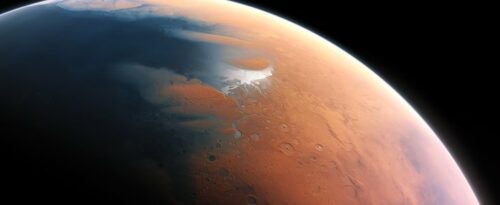Image Courtesy of ESO/M. Kornmesser.
Has life existed on Mars? If so, how would it have affected Mars’s climate? There has been ample research on Earth’s early life forms and their effect on the planet. Scientists have been particularly interested in methanogens, microorganisms that consume hydrogen (H2) and carbon dioxide (CO2) and generate methane (CH4) as waste. Both CO2 and CH4 are greenhouse gases, which trap heat in the atmosphere and lead to temperature increases, but CH4 retains twenty-five times more heat than CO2. Therefore, methanogen metabolism increased global temperature and, as a result, made Earth habitable to other organisms.
However, a recent study in Nature Astronomy found that if methanogens ever existed on early Mars during the Noachian period (about four billion years ago), they would have had an opposite cooling effect. This is because early Mars had a CO2-dominated atmosphere, as opposed to early Earth’s nitrogen-dominated atmosphere. Collisions between CO2 and H2 molecules absorb more heat energy than CO2-CH4 collisions or CH4 alone.
Since the existence of methanogens would have drastically changed the climate, it is important to evaluate whether the early Mars environment could support methanogenic life. The researchers concluded that Mars’ subsurface environment was probably favorable to microbial life. Mars’ crust is covered by regolith, a loose, heterogeneous layer made of dust, sand, and broken rocks. At that time, regolith may have sheltered microorganisms from ultraviolet and cosmic radiation. Simultaneously, brine, highly-concentrated salt water, would have filled the porous layer and provided an aqueous environment.
In addition to an aqueous solution and shelter from radiation, the land must also have been free of surface ice to sustain life. Ice-free regions allow gases to exchange from the atmosphere, which microorganisms need to survive. Ice coverage depends on surface temperature and the brine freezing point. Researchers estimated the surface temperature on early Mars by modeling H2 and CH4 concentrations combined with the latitude and elevation of any given geographical area. They found that before any life forms existed, the average surface temperature ranged from 216 to 294 K (-57 to 21℃). Brine’s freezing point, however, is largely unknown. As salt concentration increases, the solution’s freezing point decreases, which is why we salt the road before a snowfall to prevent snow from settling. Brine likely consisted of other ions besides sodium and chloride, which would also have altered the freezing point. Estimates of early Mars brine freezing points from existing literature range from 203 to 273 K (-70 to 0℃).
Researchers ran three models, estimating the probability of methanogenic life with brine freezing points of 203, 252, or 273 K. If brine had a lower freezing point, more area would be ice-free and habitable. With a freezing point of 203 K, one hundred percent of Mars’ surface would have been ice-free, whereas simulations at 273 K generated a median of only 0.15 percent ice-free area. In all three cases, some parts of Mars would have been habitable to methanogens, typically in lowlands at low-to-medium latitudes. It is important to note that this study only shows that early Mars satisfied every condition for methanogenic life rather than confirming the existence of life. However, the studies’ findings will inform the search for traces of life in fossil records.
If methanogens had really existed, their metabolic activity would have significantly changed Mars’ climate, leading to new equilibrium temperature and atmospheric composition. The study estimates a reduction of 33 to 45 K. As a result, the fraction of ice-free regions would have dropped, and habitability would have been compromised. Even in places with no ice coverage, methanogens would have been forced deeper into the crust, which was warmer but scarcer in essential gases. Somewhat counterintuitively, if Mars had a lower brine freezing point, more methanogens could have existed in the first place, but they would have induced a larger drop in temperature and lower habitability at the steady state. Unlike on Earth, where the first life forms facilitated the emergence of later organisms, life on Mars may have been its own undoing.

